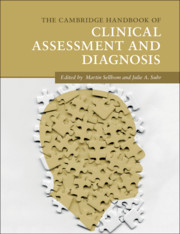Book contents
- The Cambridge Handbook of Clinical Assessment and Diagnosis
- The Cambridge Handbook of Clinical Assessment and Diagnosis
- Copyright page
- Contents
- Figures
- Tables
- Contributors
- Acknowledgments
- 1 Introduction to the Handbook of Clinical Assessment and Diagnosis
- Part I General Issues in Clinical Assessment and Diagnosis
- Part II Specific Clinical Assessment Methods
- 10 Clinical Interviewing
- 11 Multi-Informant Assessment of Psychopathology from Preschool through Old Age
- 12 Intellectual Assessment
- 13 Achievement Assessment
- 14 Using Vocational Assessment Tests
- 15 Neuropsychological Testing and Assessment
- 16 Minnesota Multiphasic Personality Inventory-2-Restructured Form (MMPI-2-RF)
- 17 Personality Assessment Inventory
- 18 The Millon Clinical Multiaxial Inventory-IV (MCMI-IV)
- 19 Self-Report Scales for Common Mental Disorders
- 20 Performance-Based Techniques
- Part III Assessment and Diagnosis of Specific Mental Disorders
- Part IV Clinical Assessment in Specific Settings
- Index
- References
14 - Using Vocational Assessment Tests
from Part II - Specific Clinical Assessment Methods
Published online by Cambridge University Press: 06 December 2019
- The Cambridge Handbook of Clinical Assessment and Diagnosis
- The Cambridge Handbook of Clinical Assessment and Diagnosis
- Copyright page
- Contents
- Figures
- Tables
- Contributors
- Acknowledgments
- 1 Introduction to the Handbook of Clinical Assessment and Diagnosis
- Part I General Issues in Clinical Assessment and Diagnosis
- Part II Specific Clinical Assessment Methods
- 10 Clinical Interviewing
- 11 Multi-Informant Assessment of Psychopathology from Preschool through Old Age
- 12 Intellectual Assessment
- 13 Achievement Assessment
- 14 Using Vocational Assessment Tests
- 15 Neuropsychological Testing and Assessment
- 16 Minnesota Multiphasic Personality Inventory-2-Restructured Form (MMPI-2-RF)
- 17 Personality Assessment Inventory
- 18 The Millon Clinical Multiaxial Inventory-IV (MCMI-IV)
- 19 Self-Report Scales for Common Mental Disorders
- 20 Performance-Based Techniques
- Part III Assessment and Diagnosis of Specific Mental Disorders
- Part IV Clinical Assessment in Specific Settings
- Index
- References
Summary
Vocational assessment includes tests designed to measure work-related characteristics, such as interests, values, personality, skills, abilities, and self-efficacy. Vocational assessment is typically conducted to provide information for the client in the context of individual career counseling or other career intervention, but also may be used in other settings within professional psychology. The primary goals typically are to increase individuals’ self-exploration and self-understanding, and to improve outcomes such as career choice fit or job satisfaction. This chapter describes commonly used measures of interests (Strong Interest Inventory, Self-Directed Search, and O*NET Interest Profiler), work values (Minnesota Importance Questionnaire and O*NET Work Importance Profiler), self-efficacy (Skills Confidence Inventory), and career adaptability (Career Adapt-Abilities Scale), as well as using traditional measures of personality. Future directions include integrated assessment platforms, connection of results to databases of occupational information, and attention to intersecting gender and cultural identities.
Keywords
- Type
- Chapter
- Information
- The Cambridge Handbook of Clinical Assessment and Diagnosis , pp. 180 - 190Publisher: Cambridge University PressPrint publication year: 2019
References
- 1
- Cited by

